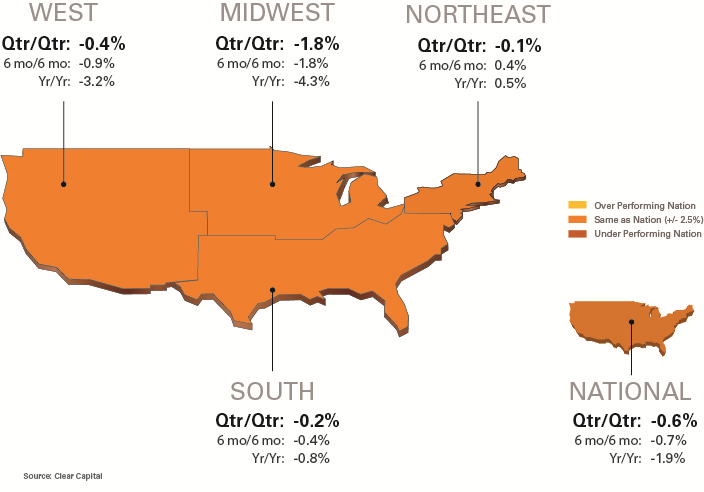Year-over-year losses are at lowest levels since April 2011, quarterly prices virtually unchanged. TRUCKEE, Calif. – Mar. 6, 2012 – Clear Capital (www.clearcapital.com), a premium provider of data and real estate asset valuation, investment and risk assessment, today released its Home Data Index™ (HDI) Market Report with data through the end of February 2012. The HDI Market Report uses a broad array of public and proprietary data sources to include data current up through the previous month offering the most timely and relevant data and analysis available. March report highlights include:
 [/caption] Prices Weaker, But Putting Up a Good Fight
[/caption] Prices Weaker, But Putting Up a Good Fight
The chart shows the relationship between prices and REO saturation with the Midwest showing the largest increase in REO saturation and the largest drop in short term prices. The rest of the numbers line up expectedly, with notable exception of the South which is showing a small decrease in REO saturation along with a small decrease in prices. This could be a red flag for the region, but as both numbers show less than 1% change, further observation will be needed to see if these trends continue. With the exception of this quarter, national REO saturation declined over the last year, providing evidence to suggest banks might have put the brakes on processing foreclosures as they waited for further clarity on regulatory guidelines, and in particular, the Attorneys General settlement with servicers. Read full article
- Year-over-year home prices for the nation are down, with quarter-over-quarter prices remaining very stable.
- All regions showed improvements in quarterly and yearly prices, while three out of four saw upticks in REO saturation.
- Top 15 MSAs resilient against notably higher REO saturation, and showing higher average gains than last month.
- All of the lowest performing MSAs saw quarter-over-quarter losses, but softer than in February.
Regional Market Overview
[caption id="attachment_7287" align="alignleft" width="632" caption="Regional Market View"] [/caption] Prices Weaker, But Putting Up a Good Fight
[/caption] Prices Weaker, But Putting Up a Good Fight
- The nation’s housing market lost less than 2% of its value year-over-year, showing an increased stability.
- The West and Midwest are still losing ground in year-over-year performance, with losses significantly above the other regions and the nation’s average.
- Quarterly numbers across all regions and nation showing softer losses (all under 2%) as compared to previous months.
- All values for all regions are improved over last month, despite mostly higher levels of REO saturation.
| Region | Change in Q/Q Prices | Change in REO Saturation | Total REO Saturation | |||
| West | -0.4% | 0.8% | 32.1% | |||
| Midwest | -1.8% | 2.1% | 32.2% | |||
| Northeast | -0.1% | 1.0% | 8.8% | |||
| South | -0.2% | -0.6% | 23.7% | |||
| Nation | -0.6% | 0.2% | 25.8% |



